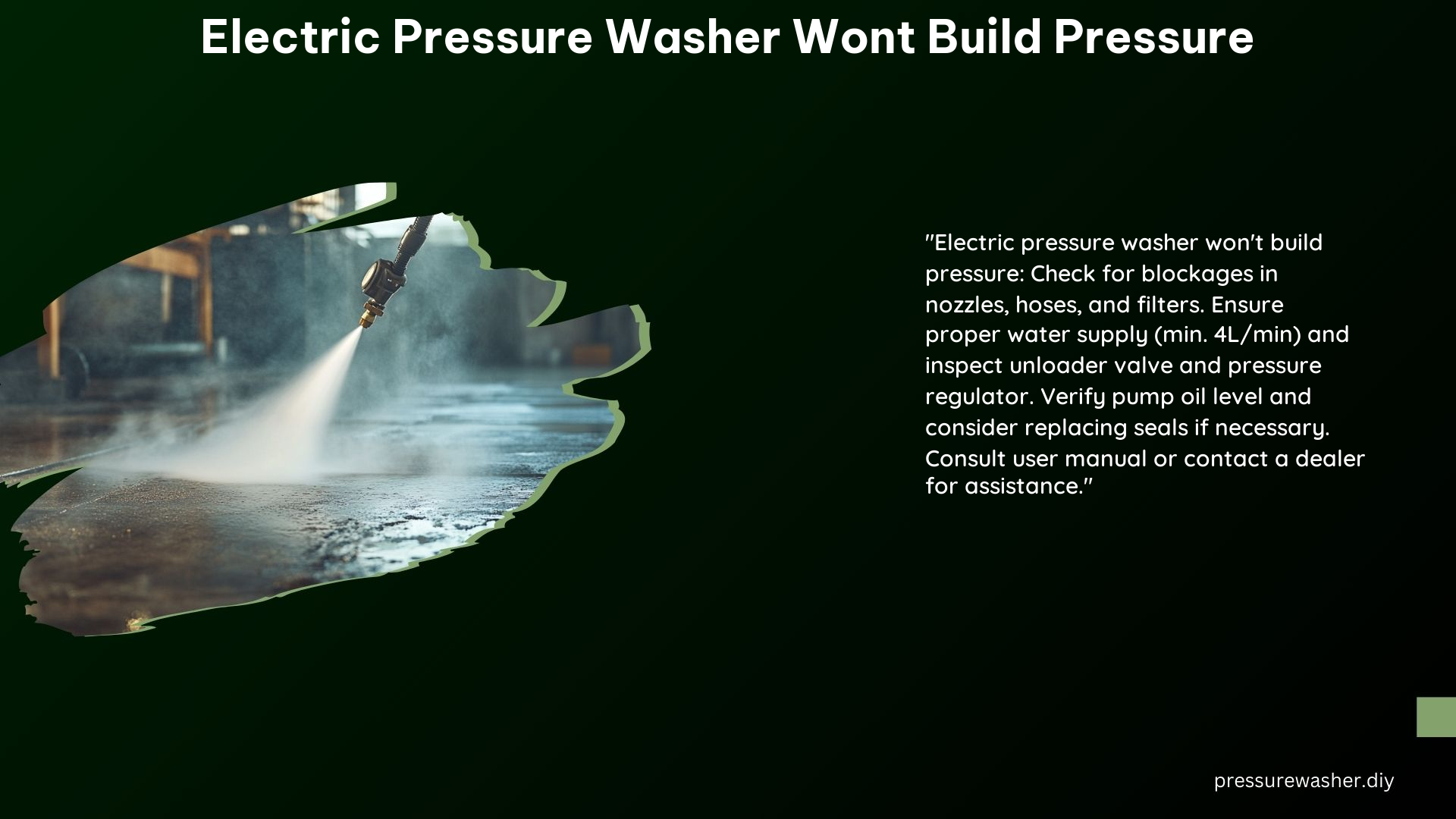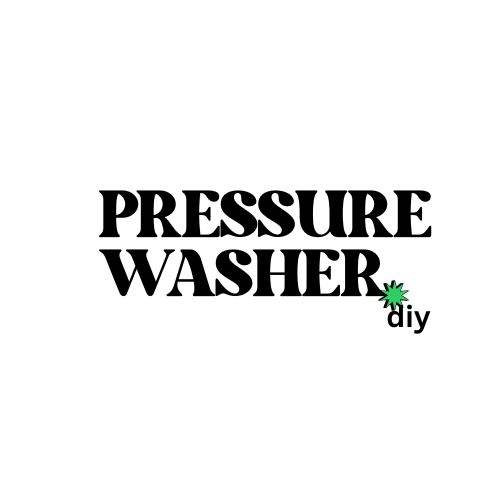If your electric pressure washer is not building pressure, there are several common causes to check and troubleshoot. This comprehensive guide will provide advanced and critical details to help you identify and fix the issue with your electric pressure washer.
Common Causes of Low Pressure in an Electric Pressure Washer
1. Blocked or Worn Nozzle
- Symptoms: Weak or irregular spray pattern.
- Solution: Clean or replace the nozzle. Check for blockages and ensure the nozzle is securely attached to the wand.
- Technical Details: The nozzle orifice size is a critical factor in determining the pressure output of the pressure washer. A blocked or worn nozzle can significantly reduce the water flow and pressure. The recommended nozzle orifice size for most electric pressure washers is between 0.3 and 0.5 inches in diameter.
2. Clogged Inlet Screen
- Symptoms: Low water flow or pressure.
- Solution: Disconnect the garden hose, clean the inlet screen, and replace it if damaged.
- Technical Details: The inlet screen filters out debris and contaminants from the water supply, preventing them from entering the pump. A clogged inlet screen can restrict water flow, leading to low pressure. The recommended mesh size for the inlet screen is typically 50-80 mesh (0.297-0.177 mm).
3. Unloader Valve Issues
- Symptoms: No pressure or water output.
- Solution: Check and clean or replace the unloader valve. Ensure proper installation and functioning.
- Technical Details: The unloader valve is responsible for regulating the pressure in the system. If the unloader valve is stuck, malfunctioning, or not properly adjusted, it can prevent the pressure washer from building pressure. The unloader valve should be set to the manufacturer’s recommended pressure, typically between 1,500 and 3,000 PSI for electric pressure washers.
4. Belt Slippage
- Symptoms: Engine running but no pressure.
- Solution: Inspect and adjust or replace the belt if necessary.
- Technical Details: The belt connects the electric motor to the pump, transferring power. If the belt is worn, loose, or slipping, it can prevent the pump from generating the necessary pressure. The belt tension should be checked and adjusted according to the manufacturer’s specifications, typically between 30-50 lbs of force.
5. Low Water Supply Pressure
- Symptoms: Low pressure or water flow.
- Solution: Check the water supply pressure and flow rate. Ensure a minimum of 20 PSI and 4 GPM (25 PSI and 7 GPM for POWERflow+ models).
- Technical Details: Electric pressure washers require a minimum water supply pressure and flow rate to function properly. If the water supply pressure is too low or the flow rate is insufficient, the pressure washer will not be able to build the necessary pressure. The recommended water supply pressure for most electric pressure washers is between 20-100 PSI, and the minimum flow rate is 4 GPM.
6. Pump Oil Level
- Symptoms: Low pressure or pump failure.
- Solution: Check and maintain the recommended pump oil level.
- Technical Details: The pressure washer pump requires a specific amount of oil to operate correctly. If the oil level is low, it can lead to increased friction, heat buildup, and ultimately pump failure. The recommended pump oil type and quantity vary by model, but typically range from 4 to 8 ounces of SAE 30 or 10W-30 non-detergent oil.
7. Pump Failure
- Symptoms: No pressure or water output.
- Solution: Test the pump by attaching a garden hose and checking for increased water flow when the engine is turned on. If not, the pump may be faulty.
- Technical Details: The pressure washer pump is the heart of the system, responsible for generating the high-pressure water flow. If the pump is damaged, worn, or malfunctioning, it will not be able to build pressure. To test the pump, disconnect the high-pressure hose and attach a garden hose directly to the pump inlet. Turn on the pressure washer and observe the water flow. If the flow does not increase significantly when the engine is running, the pump may need to be repaired or replaced.
Technical Specifications and Troubleshooting Steps

- Engine Speed: Ensure the engine is running at full speed (FAST throttle setting). The engine speed should be maintained at the manufacturer’s recommended RPM, typically between 3,000-3,600 RPM.
- Nozzle Orifice: Clean the nozzle orifice using a wire tool from the maintenance kit. The recommended nozzle orifice size is typically between 0.3-0.5 inches in diameter.
- Water Temperature: Ensure the water supply temperature is below 100°F. Excessive water temperature can cause cavitation and damage the pump.
- Pump Oil Level: Maintain the recommended pump oil level, typically between 4-8 ounces of SAE 30 or 10W-30 non-detergent oil.
- Unloader Valve: Check and clean or replace the unloader valve. Ensure the unloader valve is properly adjusted to the manufacturer’s recommended pressure setting.
- Inlet Hose: Ensure the inlet hose is not kinked, leaking, or too narrow (minimum 4L per minute flow rate). The inlet hose should be at least 1/2 inch in diameter to provide sufficient water flow.
By following these advanced troubleshooting steps and technical specifications, you should be able to identify and resolve the issue with your electric pressure washer not building pressure.
Reference:
- Briggs & Stratton – Troubleshooting Pressure Washer Problems: https://www.briggsandstratton.com/na/en_us/support/faqs/browse/pressure-washer-produces-low-pressure.html
- Reddit – Help Pressure Washer is Not Building Pressure: https://www.reddit.com/r/pressurewashing/comments/xfdn2y/help_pressure_washer_is_not_building_pressure_see/
- Red Power Magazine – Pressure Washer Won’t Build Pressure: https://www.redpowermagazine.com/forums/topic/152952-pressure-washer-wont-build-pressure/
- JustAnswer – Electric Pressure Washer No Water Pressure Coming Out: https://www.justanswer.com/small-engine/mqqaz-electric-pressure-washer-no-water-pressure-coming.html
- Husqvarna NZ – Pressure Washer Repair Guide: https://www.husqvarna.com/nz/learn-and-discover/why-has-my-pressure-washer-lost-pressure-pressure-washer-repair-guide/
